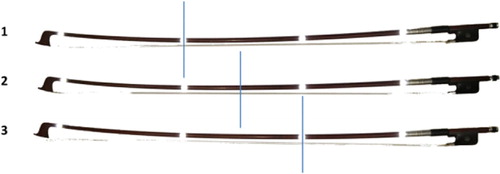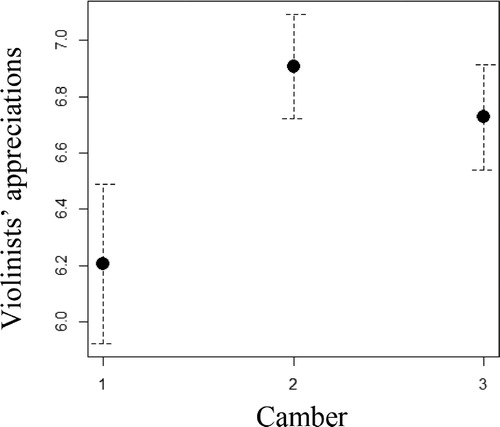1. Introduction
Violin’s bows are made of Pernambuco wood. However, trade in this wood is now restricted, leading to new research on bow design for understanding and maintaining bow performance. For now, existing studies comparing instruments from a perceptual point of view were related to the violin itself (Fritz and Dubois Citation2015). Studies about bows focused on the influence of bowing parameters (velocity, force and bridge distance) on the sound (Schoonderwaldt Citation2009), while bow perception was neglected.
The goal of the present study was to assess the impact of bow camber and inertia on the sound and on violinists’ preferences.
2. Methods
2.1. Participants and bow patterns
Ten professional violinists (9 females, 1 male, age 28.1 ± 7.9 years old, 21.1 ± 9 years of practice) were recruited (UdeM Ethics Committee). All participants played their own violin, but with a unique pernambouc bow. The bow characteristics were randomly changed behind a curtain to shape three cambers by a renown bowman () and then, for each camber, six combinations of masses were added on the frog (0 or 1 g) and/or on the tip (0, 1 or 2 g) to modify its inertia. Eighteen bow configurations were thus used by each violinist.
2.2. Data collection
The violinists were asked to play a music score, including a given theme played legato and then spiccato, at 60 and 120 bpm (). Afterwards, they had to rate the bow on a scale of one to ten, for legato playing, for spiccato and globally.
Figure 2. A violinist participating in the study (Duprey et al. Citation2017).

2.3. Data processing
The timbre was characterized by audio descriptors applied on a given musical note: C3-sharp (277.2 Hz). C3-sharps were manually extracted using Audacity (https://www.audacityteam.org/). A 6th order high pass Butterworth filter was applied with a cut off frequency of 40 Hz to remove the background noise. Then, the Matlab Timbre Toolbox was used (Peeters et al. Citation2011). As recommended by Peeters et al. (Citation2011) we used the less redundant (0.8 median absolute rank correlation threshold), most musically significant Timbre Toolbox audio descriptors: RMS energy *, attack* and decay duration*, energy modulation (frequency* and amplitude*), spectral centroid, spectro-temporal variation, spectral flatness, spectral crest, fundamental frequency, noisiness*, inharmonicity, tristimuli, odd-to-even harmonic energy ratio (*indicates that only these descriptors were applied to the filtered signal).
We assessed the relationships between bow patterns and the dependant variables, i.e., violinists’ preferences and audio descriptors (ANOVA, R software). The relationships between the dependant variables were also assessed. Reproducibility of bow rating was assessed by the coefficients of variation (CV) s with a model taking into account the subject effect.
3. Results and discussion
The subject effect was paramount in the violinists’ preferences and for all for all audio descriptors (p < 0.001).
3.1. Violinists’ preferences
After taking into account the subject effect (ANOVA), we observed a significant effect of the mass at the tip on the spiccato appreciation (p < 0.05) (), as well as a significant effect of the interaction between the camber and subject effects on the whole set of appreciations (p < 0.01 for the legato and spiccato appreciations, p < 0.001 for the global appreciation with in this case an effect of the camber alone (p < 0.05). There was no interaction between the effects ‘camber’ and ‘mass at the tip’. The preferred configurations were the absence of mass at the tip (6.6/10 vs 6.5 with 0.5 g and 5.8 with 1 g) and the camber #2 (6.9) followed by the cambers #3 (6.7) and #1 (6.2) ().
The global appreciation was correlated to both the spiccato appreciation and to the legato appreciation (r = 0.84 and 0.87, respectively). The spiccato and legato appreciations were less interrelated (r = 0.62).
The repeatability of the assessments, after taking into account the subject effect, was good, with a CV of 0.07 to 0.08.
3.2. Audio descriptors
After taking into account the subject effect, we observed a significant effect of the camber on the odd-to-even harmonic energy ratio (p < 0.001), and of the interaction between the camber et subjet effects on the RMS energy (p < 0.05), spectral centroid (p < 0.01), spectro-temporal variation (p < 0.05), noisiness (p < 0.01), odd-to-even harmonic energy ratio (p < 0.001). Mass at the frog had an influence on the tristimuli 1 (p < 0.01).
Many audio-descriptors were interrelated. As shown by the description of the main axes provided by a Principal Component Analysis, the most interrelated descriptors (p < 0.05) were as follows.
RMS energy was linked with the spectral centroid (-0.46) spectro-temporal variation (-0.36) and noisiness (-0.91).
Noisiness was linked to spectral centroid (0.41), to odd-to-even harmonic energy ratio (-0.41) and to inharmonicity (0.37).
Tristimuli 2 and 3 (r = 0.62) were linked to the odd-to-even harmonic energy ratio (-0.35 and
-0.39), to inharmonicity (0.39 and 0.34), and to the fundamental frequency (-0.37 and -0.30).
Energy modulation (frequency and amplitude) was linked to attack duration (0.30 and -0.26).
Violinists preferences were not linked to any audio descriptors.
4. Conclusion
The main result is that the bow camber was the parameter that most affected both the preferences and the audio descriptors, while mass distribution did not influence much the results.
The most common designed camber (camber #1) was actually not the preferred one, but with great variations among participants subjects. As for mass distribution, additional masses at the tip were not appreciated when playing spiccato. Since playing spiccato requires a specific control of the bow, this result may be explained by the inertial changes induced by masses at the tip.
Asking the violinist for three different appreciations appeared as unnecessary since they were closely interrelated. Finally, it was expected that violinist’s preferences would be linked to the sound descriptors. However, no correlation was obtained between the appreciations and the audio descriptors yet. As a perspective, statistical links between the preferences and audio descriptors with biomechanical parameters (upper limb joint angles and muscular activities) will be investigated.
References
- Duprey S, Michaud B, Begon M. 2017. Muscular activity variations of the right bowing arm of the violin player. Comput Methods Biomech Biomed Eng. 20(sup1):71–72.
- Fritz C, Dubois D. 2015. Perceptual evaluation of musical instruments: state of the art and methodology. Acta Acust Acust. 101(2):369–381.
- Peeters G, Giordano BL, Susini P, Misdariis N, McAdams S. 2011. The Timbre Toolbox: extracting audio descriptors from musical signals. J Acoust Soc Am. 130(5):2902–2916.
- Schoonderwaldt E. 2009. The violinist’s sound palette: spectral centroid, pitch flattening and anomalous low frequencies. Acta Acust Acust. 95(5):901–914.


